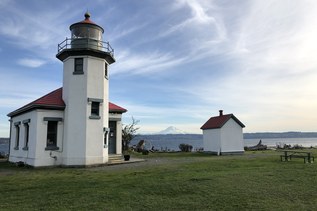This wild wood started out as a working farm and timber producing homestead over one hundred years ago. It became part of the Snohomish County Park system in 2000, and now is in the process of returning to the wild state it once was. We hikers can watch this dynamic landscape by following the many trails that run through it. The trails are all well signed and a map can be printed or downloaded to your smartphone from the Snohomish County Parks website. Hike the perimeter trails for a good sampling of the area and a nice hike of about 5 miles.
Take a minute to read the trailhead kiosk before you start, then head down the Mainline trail from the parking lot. A short interpretive loop walk along the Whispering Firs trail on the right will give you a nice overview of the plants found along the trails and their role in the ecosystem. Once back on the Mainline trail, walk a short way until you intersect with the Wetland Plateau trail on the left. Turn on this trail and follow this very gentle uphill grade. Here you will notice the red alder in this area. This is the most recently logged area, as alder is the first tree to grow back. Look for salmonberry and red huckleberry in the thicket of deciduous shrubs.
Salmonberry has bright magenta-pink flowers in the spring and tasty orange to red berries in summer. Red huckleberry has small bell-like flowers and red berries. It is closely related to the mountain huckleberry found at higher elevations. There has been rumors of a resident bear living in these woods, perhaps you will see him if the berries are ripe.
Unfortunately, the view at the former overlook has been blocked by the vegetation growth and the rotted bench has been removed.
The Wetland Plateau trail intersects the Southern Traverse trail; head right on the Southern Traverse trail. This section is fairly flat and winds through a more mature second growth forest of western hemlock and western cedar. Notice the decaying alder trunks, now serving as 'habitat' trees. As they decay, these trees provide insects and nesting sites for birds and small mammals. In the spring, watch for clumps of white trillium as you hike through this section.
You will soon come to a main intersection with the Forest Ridge and the Lloyd trail, stay on the Southern Traverse. The trail then drops down a little and come to Smokey's bridge, a puncheon bridge skirting a large muddy area that becomes a small pond in winter rains. Who was Smokey, one wonders, perhaps a trail worker that helped on the project? Nothing tells us, there is just the sign.
Head back up a gentle grade and intersect here with the Mainline trail and the Bigleaf trail. Take the Bigleaf trail, named for the bigleaf maple you will find growing in the park. A large spreading multi trunk tree, it is easily identified by the very large leaves that turn golden in the fall. Wander along this trail, enjoying the forest. This is truly a mixed forest, young fir, hemlock and cedar trees mix with vine maple, and alder. Underneath there is a carpeting of western bleeding heart in the spring.
The Bigleaf ends in a T with the Red Alder trail. Either way on the Red Alder will take you back to the trailhead, take the left fork for a bit more wandering. This trail will wander through some large Doug fir, second growth trees that are one hundred years old. The forest returns! You will also see some dying trees here too, western white pine being felled by disease. The bark is black and the dead branches circle the trunk in a whorled pattern. Look carefully, though, seedlings are to be found among the understory of Oregon grape, salal and swordfern.
You may finish your hike by taking the Mainline trail back toward the parking lot or continue exploring if you wish, there are thirteen miles of trail here. Just off the Mainline trail on your way back there is a nice place for lunch at a spot labeled The Clearing, here you will find a picnic table. If you didn't bring a lunch, the Maltby Cafe, just west of the crossing of 522 is a local favorite.






 Trailhead
Trailhead


